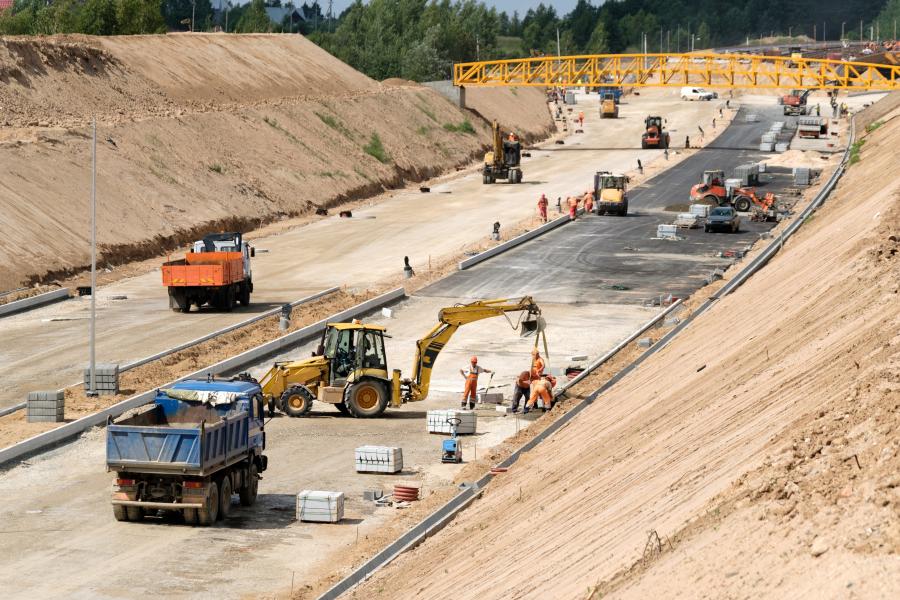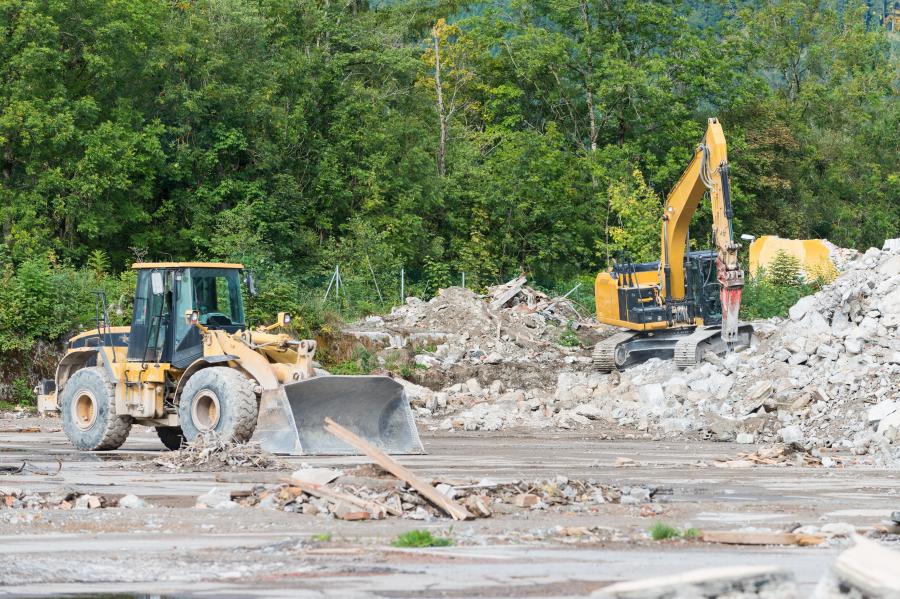The Bipartisan Infrastructure Law, intended to improve communities nationwide, has reached the one-year mark.
Mid-November marked the end of year one of the bipartisan Infrastructure Investment and Jobs Act (IIJA), and ARTBA reviewed U.S. Treasury Department data on new project starts spawned by the bill. The road and bridge construction association reports that 29,000 new projects were supported by $53.5 billion in highway and bridge formula funds leveraged at the state level.
"A key takeaway from the Treasury data is that the bipartisan infrastructure law is working in year-one as intended," said Dr. Alison Premo Black, ARTBA chief economist. State transportation departments are "disbursing their funds and projects breaking ground."
The numbers represent nearly 90 percent of IIJA's highway funds, dispersed by existing formula to states.
The remainder, according to ARTBA, are distributed through discretionary grant awards and other allocated programs.
Tracking Progress, Projects
"The economic and quality of life benefits of the infrastructure law will become even more apparent as funding continues in coming years," the association said.
ARTBA is tracking the number and location of these construction projects on its Highway Dashboard, launched at the IIJA one-year mark.
The American Society of Civil Engineers (ASCE) also is tracking IIJA projects, in partnership with Accelerator for America.
The map features projects getting under way with IIJA funding, which the associations reports has been steadily making its way to state and local agencies across the nation.
"The Bipartisan Infrastructure Law is improving communities large and small," said Maria Lehman, ASCE president. "But many Americans aren't aware of how this law will impact their day-to-day lives."
She said the mapping tool will show families how traffic along their morning commutes is going to be alleviated, why they're experiencing less interruptions in energy services, or why their tap water will be safer to drink.
"Not only will these projects improve our quality of life, but we hope they also inspire the next generation of civil engineers to be a part of solving some of society's most complex problems."
All 17 infrastructure categories in ASCE's Report Card for America's Infrastructure are touched by the IIJA, according to the association.
The report card, which gave U.S. infrastructure a grade of ‘C-', and the map are part of ASCE's efforts to track all infrastructure investments and rulemakings by sector.
White House's Perspective
At the IIJA one-year mark, President Joe Biden's White House called it "a once-in-a-generation investment in our nation's infrastructure and competitiveness."
The Biden-Harris Administration "is already following through on its promise to deliver results by rebuilding our roads, bridges, ports and airports."
Touting IIJA's historic progress, the White House claims it is the largest and most significant investment in rebuilding our roads and bridges since President Eisenhower's Interstate Highway System. It represents the largest investment in public transit and transit accessibility in American history and the biggest investment in passenger rail since Amtrak's inception, as well as the greatest investment in clean water, affordable internet, environmental justice, clean energy and resistance to climate change.
It also claims clean, electric buses for school and transit fleets; an EV charging grid and the largest investment in domestic manufacture of batteries.
Specifically, almost 3,000 bridge repair and replacement projects have launched across the country.
The bill spawned funding for more than 5,000 new clean transit and school buses, according to the Biden administration.
The DOT and FHWA announced some $120 billion in federal highway apportionments for highways and bridges for fiscal years 2022 and 2023.
The Federal Railroad Administration outlined major backlog projects that will get funding.
The DOT awarded $1.5 billion in 26 highway, multimodal freight and rail projects to shore up the nation's transportation systems, eliminate supply chain bottlenecks and improve critical freight movements.
USDOT also announced $2.2 billion in Rebuilding American Infrastructure with Sustainability and Equity (RAISE) grants for 166 projects.
These projects will allow urban and rural communities to move forward on projects that modernize roads, bridges, transit, rail, ports and intermodal transportation.
They'll also make U.S. transportation systems "safer, more accessible, more affordable, and more sustainable," according to the White House.
More than $20.4 billion in Fiscal Year 2022 is earmarked for transit funding, and another $4.45 billion recommended through the Capital Investment Grants program.
Almost $2 billion in awards is set to help transit agencies, states and territories purchase low- and no-emission transit buses and upgrade facilities.
"These awards will help communities across the country purchase more than 1,800 new buses and double the number of clean transit buses on America's roads," said the Biden administration.
The EPA awarded about $1 billion in clean school bus rebates to nearly 400 school districts.
The grants will help school districts purchase more than 2,400 clean school buses.
The DOT announced $1.75 billion to improve transit accessibility across the country as part of the department's new All Stations Accessibility Program (ASAP). The program will help transit agencies update subway and rail stations built before passage of the ADA.
The first $343 million to make subway and rail stations more accessible was released this summer.
The FAA earmarked $3 billion for 3,075 to upgrade critical airport infrastructure nationwide. The agency also announced a $1 billion in awards to 85 airports across the country to modernize airport terminals.
The U.S. Army Corps of Engineers (USACE) set almost $4 billion to strengthen supply chains and improve waterways.
The Maritime Administration (MARAD) also announced more than $700 million to fund 41 port projects to improve our nation's port infrastructure.
The GSA awarded more than $3 billion to modernize 26 land ports of entry across the northern and southern borders.
The investments will improve commerce and trade; enhance border security; create good-paying construction jobs; incorporate new and innovative sustainability features; and provide for improved climate resilience, the agency said.
Work has begun, and GSA also has completed seven port paving projects using low-carbon asphalt and concrete specifications.
The contracts for these paving projects were awarded to and completed by women-owned, small or disadvantaged businesses.
Electric vehicle infrastructure deployment plans have been deployed for all 50 States, the District of Columbia and Puerto Rico.
All states now have access to funding totaling more than $1.5 billion to help build EV chargers covering approximately 75,000 miles of highway across the country.
The Joint Office of Energy & Transportation was formed to focus on building the national charging network.
The EPA announced more than $9 billion to upgrade aging water infrastructure, sewerage systems, pipes and service lines. The EPA's State Revolving Fund programs include targeting resources to disadvantaged communities, making rapid progress on lead-free water for all and tackling dangerous chemicals
The USACE earmarked $200 million for environmental infrastructure projects.
The Department of the Interior (DOI) set $20 million in IIJA funds to build climate resilience in Tribal communities. The DOI announced nearly $2 billion to fulfill Indian Water Rights Settlements, $10 million for tribal water systems and another $10 million for irrigation and power.
Tribal sanitation projects will receive $700 million in support for clean water and sanitation systems.
The DOI set aside $1.4 billion for 129 projects to boost water infrastructure and tackle drought.
The Department of Agriculture (USDA) earmarked nearly $800 million for projects that improve watersheds dams and flood prevention.
The USACE received $64 million to fund safety projects to maintain, upgrade and repair dams owned by non-federal entities.
The DOI, USDA, and DOD announced a $1 billion America the Beautiful Challenge combining federal funding with private and philanthropic contributions for conservation and restoration.
The USACE set aside almost $2 billion to restore ecosystems across the nation.
The USDA announced $131 million in wildfire mitigation investments to begin work on the Forest Service 10-year wildfire risk mitigation strategy.
The DOI announced $103 million for wildfire mitigation and resilience efforts in 39 states, to support nearly 2 million acres of fuels management work.
FEMA earmarked $60 million for a federal grant initiative that will help with hurricane flooding resilience.
The USACE announced $3.7 billion in flood and coastal resilience construction projects to reduce community flood risks.
The DOI launched a nearly $5 billion program to cap and plug abandoned oil and gas wells to reduce methane emissions and create jobs.
The agency also announced that nearly $725 million is available for jobs reclaiming abandoned mines, eliminating pollution from past coal mining and providing opportunities for current and former coal workers.
The IIJA reauthorized existing distributions and provided more than $11 billion over the next 15 years.
The EPA earmarked $1 billion to address the backlog of unfunded Superfund sites and accelerate cleanup at dozens of other sites. The agency also awarded $254.5 million in brownfield clean up grants to 265 communities. The EPA announced $1 billion to advance the clean-up and restoration of the Great Lakes' most environmentally degraded sites.
The DOE awarded nearly $3 billion to boost domestic production of advanced battery components and the processing of critical materials that power them.
The DOI announced more than $167 million to fund a new facility for the U.S. Geological Survey, working on critical energy and mineral programs.
The DOE announced $2.3 billion to strengthen and modernize America's power grid.
The agency also launched a $10.5 billion program to enhance the resilience and reliability of the power grid. The DOE launched a program to help jump-start America's clean hydrogen economy, opening applications for $7 billion in funding.
"These investments will help advance President Biden's goal of a net-zero carbon economy by 2050, improve energy security, and create good-paying jobs," said the White House.
The DOI invested more than $74 million to map critical minerals that power everything from household appliances and electronics to clean energy technology like batteries and wind turbines.
The FCC launched the Affordable Connectivity Program (ACP), which lowers the cost of Internet service for eligible households. The program also provides up to $100 toward the purchase of a desktop, laptop or tablet computer.
The Biden administration secured commitments from 20 leading Internet providers to offer ACP-eligible households fully covered high-speed Internet plans.
"As a result, millions of Americans can now get high-speed internet for free," said the White House.
John Drake, vice president, transportation, infrastructure and supply chain policy, for the U.S. Chamber of Commerce, had high praise for the bill.
"It will unfurl changes that will improve how we deliver critical infrastructure while also increasing investments in the roads, bridges, utilities and other critical infrastructure that benefit our economic competitiveness and our communities," he said. "It is important to note that this investment is long-term – the funding will take time to move from Washington to project sites."
Guidelines, rules, and application procedures for disbursements must first be crafted before funding and projects can progress across the country, he added.
"While we celebrate the one-year anniversary of IIJA, the U.S. Chamber continues to urge policymakers to take additional steps to bolster the investments made.
Taking these steps, he said, "will ensure the promise of investment is able to turn into action."CEG
Lucy Perry
Lucy Perry has 30 years of experience covering the U.S. construction industry. She has served as Editor of paving and lifting magazines, and has created content for many national and international construction trade publications. A native of Baton Rouge, Louisiana, she has a Journalism degree from Louisiana State University, and is an avid fan of all LSU sports. She resides in Kansas City, Missouri, with her husband, who has turned her into a major fan of the NFL Kansas City Chiefs. When she's not chasing after Lucy, their dachshund, Lucy likes to create mixed-media art.
Read more from Lucy Perry here.
Today's top stories


















